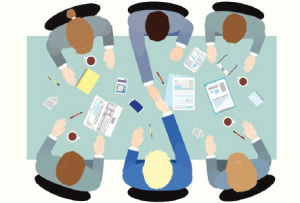Experienced lawyer or more junior, I ask the question: are you applying the right techniques for  giving you the best chances for settling your client’s case? I am not saying that I have a magic formula, but after four decades plus of serving as a civil litigation lawyer, I do have some thoughts about what can be done to improve the prospects of getting a settlement.
giving you the best chances for settling your client’s case? I am not saying that I have a magic formula, but after four decades plus of serving as a civil litigation lawyer, I do have some thoughts about what can be done to improve the prospects of getting a settlement.
Here are some thoughts:
Relationship with Opposing Counsel and Parties
First and foremost, make sure you have a professional rapport with opposing counsel and parties that encourages communication. Without that, settlement prospects are diminished.
I still see some who believe advocacy is about tension, disagreement, resistance—and sometimes even anger and hostility—when such is not appropriate. This approach gains nothing. Settlement is accomplished by those who are open, and those who communicate well. This does not mean abandoning your role as advocate. Au contraire. The word “no” can be communicated politely and professionally and without vitriol. If you maintain a professional, tough but fair position, you will be respected (usually), but most of all, your adversary will listen.
Without this approach, in my view, settlement prospects—even with a mediator—are diminished.
The Time Must Be Right
Settlement will not happen if the parties are not ready and not prepared to negotiate. So, look for the right time. I define that “right time” as a plateau—the point at which the parties can review their case, look into the future, evaluate the issues, and look at the costs of going forward versus the potential recovery. This might be early on in the case or much later.
For example, in an insurance “bad faith” case once the insurer has made a claims decision and you have obtained the claims file, a careful analysis of that file—perhaps with the help of an expert—can give you a strong indication of the merits of your case. Presented well in a demand letter with documented damages, including special damages, general damages for emotional distress (real not imagined), and attorneys fees (see Brandt v. Superior Court, 37 Cal. 3d 813 (1985)), you may be able to reach a settlement earlier rather than later.
However, in a serious personal injury case, when the injuries need time to resolve and plateau, it may take time to get to that point and assemble the requisite reports and evaluations to assess both liability and damages.
The point here is that there is a place during the course of any litigation where the parties should be prepared to negotiate, either directly or with a neutral. Recognizing the right timing takes skill, experience and basic “know how”. And it means knowing what to get in discovery, what to offer voluntarily to the other side, and how to get the parties to get to that plateau and recognize when they are there!
Know What You Need to Negotiate
From a plaintiff’s perspective, the presentation of a “demand package” that is persuasive, informative, well-documented, and useful to your adversary and the client/insurance company is a skill that not all lawyers have. That presentation must be a “mini” claims file, with the support of expert reports, analysis and documentation. It should be a trial portrait that marches off the page into the courtroom. If, as a plaintiff’s lawyer, you cannot present that type of package then the time is not right or more needs to be done.
And in addition, again from a plaintiff’s perspective, you should ask defense counsel what is needed to evaluate the case, and provide it if a legitimate request. Find out what the defense needs to get to a point where settlement is a real possibility.
Be Realistic About Your Client’s Case
I should add that in getting to this point, be realistic about your evaluation. We all know that not all cases we take work out as well as we had hoped. Some have unexpected limitations and when that is the case, and your client’s matter has limitations, recognize it, then try to get the best result you can under the circumstances. As the song goes (and I know this is trite but true), “You gotta know when to hold ‘em and know when to fold ‘em.” 1
More important is that you have to refrain from building a client’s expectations about a case or settlement value. I am frequently asked by my clients what I think about the case, often at the outset of representation. My usual response is that there appears to be a meritorious case to be pursued, but that my view of liability and damages must await further work including consulting with experts, listening to witnesses, reviewing documents and reports and reflecting on the case. Also I want to hear what the other side has to say about the case. Their view, while shaded to their perspective, must be considered. Further, if we are going to try to mediate the case, we need to see how the mediator reacts to our presentation.
Pick the Right Forum for Settlement Discussions
Critical to any successful settlement discussion is having the right forum. It may mean direct negotiations or mediation (almost always the better option in a multi-party case).
My first effort is a comprehensive demand letter as outlined above. That may invite direct negotiations, or it may result in the parties agreeing to mediate. I find that often defense counsel or the claims person needs verification by a mediator to conclude a case. That is, a claims person may feel that the “blessing” of a neutral party is necessary to verify an accepted settlement proposal. That is fine, if it results in a settlement. So if the claims person needs that verification, I will not stand in the way.
Choose the Right Mediator for the Case
More times than not, I am agreeable to using a mediator that the defense suggests unless after doing some background work, I find the mediator simply has the reputation of being defense oriented. I am not troubled by the fact that the insurance company or defendant has used the mediator several times before. If this mediator has settled the cases, I am somewhat encouraged. I often ask how many cases the mediator has done for the defendant or the insurer. That is valuable information. I also ask how many of those cases settled. Then I ask for the names of lawyers who have attended these mediations and I call and get as much information as I can so I can make an informed recommendation to my client.
Try it; it works.
Prepare Your Client for the Negotiation Process
Whether the negotiation is direct or via mediation, it is important to prepare your client for the inevitable frustrations of the process. In essence, your client needs to know how negotiations generally work. Prepare the client for the “give and take” nature of the process, and advise them not to be offended at tactics such as low starting offers or foot dragging (both commonly used by defendants and insurance companies). It is all part of the process and you need to assure your client that together you need to work through it.
The client needs to know that if this is going to work, you both need to participate and look for a breakthrough that will lead to a final settlement. Encourage, do not discourage. The latter will lead to a failed negotiation.
No doubt you have your own thoughts on this process. Though simple, these work for me; perhaps some or all will also work for you.
About the author
Guy Kornblum has been a specialist in civil trials, arbitrations and appeals since graduating from the University of California, Hastings College of the Law in 1966. He is a partner in the civil litigation firm of Kornblum, Cochran, Erickson & Harbison, LLP, with offices in San Francisco and Santa Rosa, California. He is certified in Civil Trial Law and Civil Pretrial Practice Advocacy by the National Board of Trial Advocacy. He has been a Super Lawyer each year since 2006. He is co-author of “Negotiating and Settling Tort Cases: Reaching the Settlement,” published by Thomson West and the American Association for Justice (formerly Association of Trial Lawyers of America), with a Third Edition released for 2015-16. He has also co-authored two books on insurance coverage and bad faith and over 200 published articles on topics relating to law practice and procedure. You can order his latest book; See also the review of his book.
Footnotes
1. Several sang this song, but perhaps Kenny Rogers is the most noted. The lyrics go:
“You’ve got to know when to hold ’em, know when to fold ’em, Know when to walk away, know when to run. You never count your money when you’re sittin’ at the table, There’ll be time enough for countin’ when the dealin’s done.”


